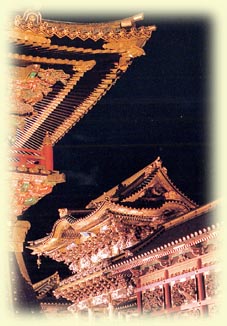|
THE WORLD OF YABUUCHI SatoshiEsculptor
|
||
|
||
| It is important for an artist to have some object or place that inspires them to creativity. In my case, there are three places that fill me with inspiration, these being the Grand Shrine of Ise in Mie Prefecture, Todaiji Temple in Nara Prefecture and the Toshogu Shrine in Nikko, Tochigi Prefecture. All three are religious sites and are the best remaining examples of ancient, Nara and Edo period architecture and art, resulting in their being popular destinations for school study trips. Another aspect that they share in common is that they have been renovated on a regular basis, allowing them to preserve their beauty to this day.It is a well-known fact that the Inner Shrine of the Grand Shrine of Ise has been rebuilt every twenty-one years since it was first constructed, supposedly in the year four B.C.. Todaiji Temple was burnt to the ground in wars in both 1180 and 1567 but both times the enormous wooden building that houses the great Buddha was rebuilt through the efforts of the priests and believers, utilizing the most advanced of techniques and knowledge available at the time. Although the Toshogu Shrine has never been dismantled and rebuilt like the Grand Shrine of Ise, the paintwork on the buildings has been regularly renewed allowing it to retain its original beauty despite the extremes of climate it has to face deep in the mountains. It stands as an eloquent proof that there is more to Japanese aesthetics than a love of rustic simplicity or elegant decay. One day in May, I was invited to visit the Shrine at Nikko as part of a television program. The newly-planted rice fields and the fresh green of the trees on the mountains provided beautiful background scenery for the trip and although I am allergic to the pollen of cedar trees, luckily, that season had just finished and I was able to enjoy a stroll along the famous cedar avenue leading to the shrine. I had visited the ruins of Angkor Wat in Cambodia the previous year and remembered having experienced a strange sense of deva vu when I saw them which mystified me, it being my first visit to the country. However, when I looked anew upon the gateways and corridors of the Toshogu Shrine, I realized that these two temples, in widely separated countries, shared a lot in common. Followers of modernism movement repeatedly criticize the brilliantly colored sculptures of the shrine claiming that they are simply stereotyped, but is this really the case? I can only recommend that they visit the shrine early in the morning before the hoards of tourists arrive and stand in front of the Yomei gateway that nestles among a grove of majestic cedar trees. If they can do this and yet still not appreciate the beautiful balance between the gilt metalwork, the graceful curve of the roof and the complex shades of color created by the huge number of sculptures below, then I can only assume that they suffer from sensual lethargy. When the camera lights were put in place for filming inside the Haiden (Worship Hall) and Ishinoma (central chamber) they revealed a delicate, subtle coloring with an underlying blue-green tone and this beautiful, refined tonal space could be said to have much in common with the work of the later impressionists, particularly with that of Monet. The Toshogu Shrine was created to be the burial place of Tokugawa Ieyasu, founder of the Tokugawa dynasty that ruled Japan from 1603 to 1867 and subsidiary shrines of the same name are to be found in Shizuoka, the Imperial Palace and Ueno in Tokyo as well as other sites that were connected to the Tokugawa family. If the sites of all these shrines are traced on a map, it can be seen that they create a regular pattern. Another interesting point concerning these shrines is that the deity venerated at the Toshogu is based on the one at the Grand Shrine in Ise. In addition, the path leading from the Yomei gateway to the main buildings runs from the south to the north and therefore points directly at the pole star. A study of the carvings that festoon the exterior of the buildings allows one to learn the meaning and significance of the imaginary beasts from Chinese mythology that they represent despite this having been long forgotten in the land of their origin. I recommend anyone interested in this subject to read "Toshogu Saihakken" (Rediscovering the Toshogu Shrine) written by the chief priest, TAKAFUJI Harutoshi and published by the Toshogu Shrine or "Zusetsu Shajikenchiku no Chokoku" (Illustrated Explanation of Temple/Shrine Architecture Sculpture) published by Tokyo Bijutsu.This visit to the Toshogu stimulated my creativity. It was as if the holy animals in the carvings were calling out to me, telling me to hurry back to my workshop so I could let them out into the world once more. Translated by Gavin Frew |
||
|
|
||
|
YABUUCHI Satoshi's Public Relations Dept.
UWAMUKI PROJECT webmaster@uwamuki.com All the text and images used on this site is copyrighted and its unauthorized use is strictly forbidden. |
